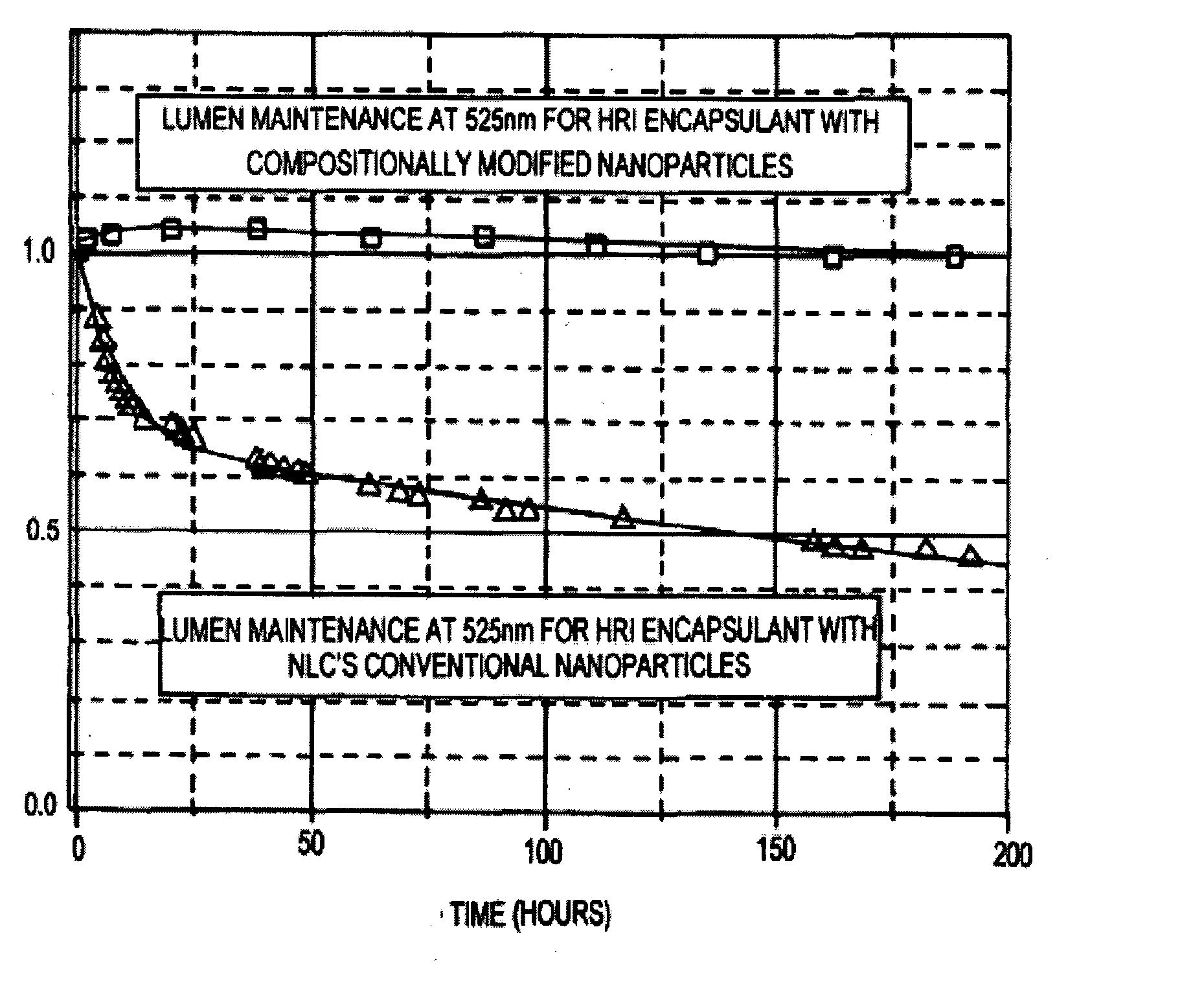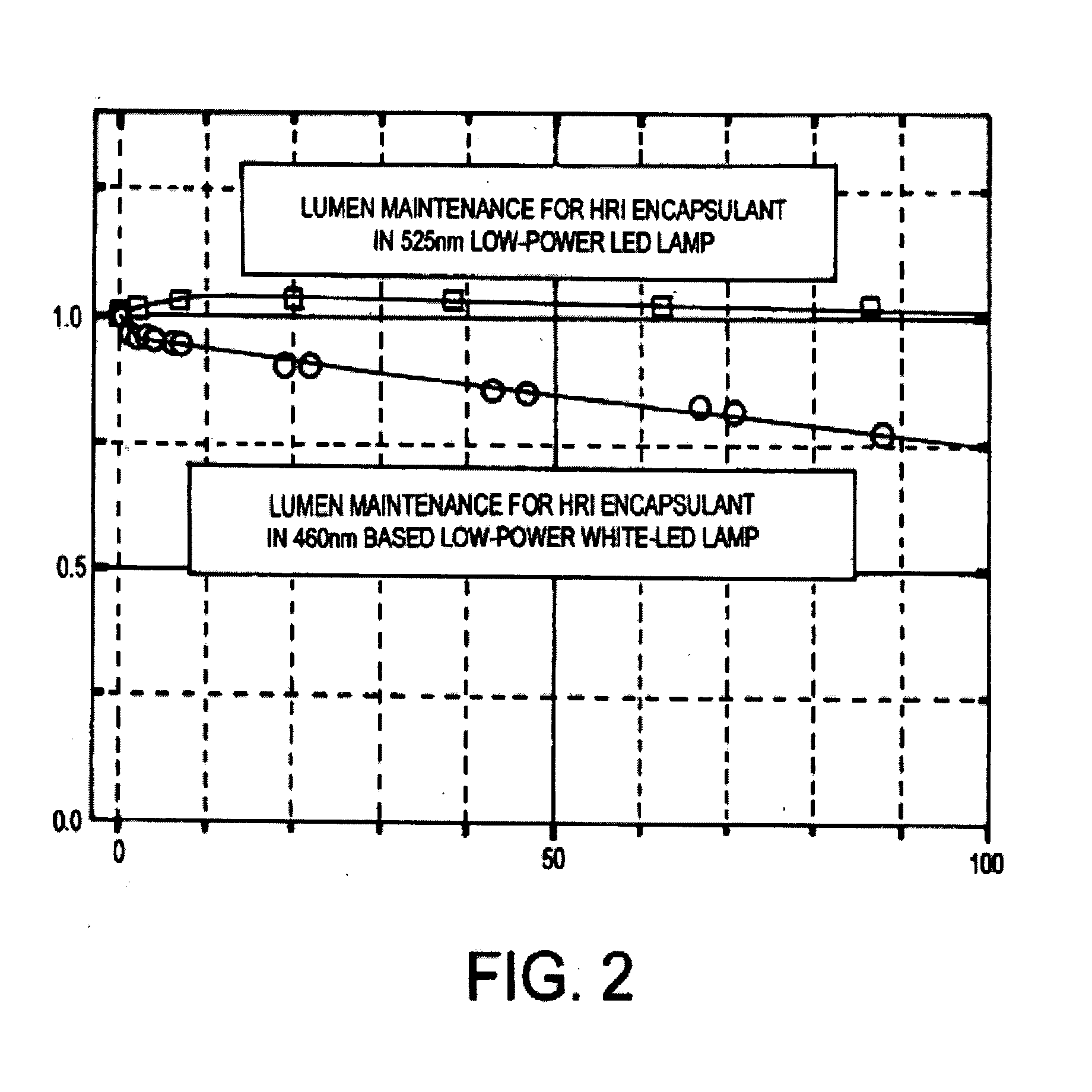Optically reliable nanoparticle based nanocomposite HRI encapsulant, photonic waveguiding material and high electric breakdown field strength insulator/encapsulant
- Summary
- Abstract
- Description
- Claims
- Application Information
AI Technical Summary
Benefits of technology
Problems solved by technology
Method used
Image
Examples
example a
HRI Epoxy Encapsulant From 4% Mg Treated Coated TiO2
[0039] The 4% Mg treated Methacrylate functional-group coated TiO2 (1.00 g) in (10 ml) 2-butanone was mixed with epoxy (Loctite OS 4000 part A) (0.58 g) in a round bottom flask and the mixture was refluxed for 3 hours. Upon cooling, the solution was concentrated on a rotary evaporator under vacuum at 50° C. until the volume was reduced to (5 ml).Thereafter 4-methyl-2-pentanone (1 ml) (Aldrich Chemical Co ) was added to the mixture and transferred to a centrifuge tube and centrifuged at 3000 rpm for 15 minutes. After centrifugation, the liquid was decanted and concentrated on a rotary evaporator to obtain the desired consistency of HRI epoxy encapsulant.
example b
HRI Epoxy-Terminated Reactive-Silicone Encapsulant From 4% Mg Treated Coated TiO2
[0040] The 4% Mg treated Octyl functional-group coated TiO2 (1.00 g) in (10 ml) Toluene was mixed with Epoxy-Terminated Silicone (0.5 g) in a round bottom flask. The solution was concentrated on a rotary evaporator under vacuum at 50° C. until the volume was reduced to obtain the desired consistency of HRI Epoxy-Terminated Silicone encapsulant. Alternately, the solution may be concentrated on a rotary evaporator under vacuum at room-temperature. Alternately, Octenyl functional-group coated TiO2 was also used in the above example.
[0041] EpoxyPropoxyPropyl-Terminated DiMethylSiloxane (or EpoxyPropoxyPropyl-Terminated DiPhenylDiMethylSiloxane or EpoxyPropoxyPropyl-Terminated PolyPhenylMethylSiloxane), which is a one of the constituents of Silicone-based elastomers for optical applications, is used to obtain a Epoxy-Terminated Silicone-based HRI encapsulant. Similarly, EpoxyPropoxyPropyl-Terminated Siloxa...
example c
HRI Vinyl-Terminated Reactive-Silicone Encapsulant From Mg Treated Coated TiO2
[0042] The 4% Mg treated Allyl functional-group coated TiO2 (1.00 g) in (10 ml) 1-butanol was mixed with Vinyl-Terminated Silicone (0.5 g) in a round bottom flask and the solution was concentrated on a rotary evaporator under vacuum at 50oC until the volume was reduced to obtain the desired consistency of HRI Vinyl-Terminated Silicone encapsulant. Alternately, the solution may be concentrated on a rotary evaporator. under vacuum at room-temperature. Vinyl-Terminated PolyPhenylMethylSiloxane (or Vinyl-Terminated DiPhenylDiMethylSiloxane or Vinyl-Terminated DiMethylSiloxane) which is a primary constituent of Silicone-based elastomers for optical applications, is used to obtain a Vinyl-Terminated Silicone-based HRI encapsulant.
PUM
| Property | Measurement | Unit |
|---|---|---|
| Particle size | aaaaa | aaaaa |
| Nanoscale particle size | aaaaa | aaaaa |
| Energy | aaaaa | aaaaa |
Abstract
Description
Claims
Application Information
 Login to View More
Login to View More - R&D
- Intellectual Property
- Life Sciences
- Materials
- Tech Scout
- Unparalleled Data Quality
- Higher Quality Content
- 60% Fewer Hallucinations
Browse by: Latest US Patents, China's latest patents, Technical Efficacy Thesaurus, Application Domain, Technology Topic, Popular Technical Reports.
© 2025 PatSnap. All rights reserved.Legal|Privacy policy|Modern Slavery Act Transparency Statement|Sitemap|About US| Contact US: help@patsnap.com



